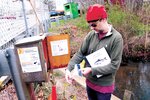By JOHN HOWELL
David Mozzoni stood watch at the Warwick Avenue bridge over Buckeye Brook Saturday about 2 p.m. He focused on a white plastic strip that spanned the brook no more than two …
This item is available in full to subscribers.
We have recently launched a new and improved website. To continue reading, you will need to either log into your subscriber account, or purchase a new subscription.
If you are a current print subscriber, you can set up a free website account by clicking here.
Otherwise, click here to view your options for subscribing.
Please log in to continue |
|


By JOHN HOWELL
David Mozzoni stood watch at the Warwick Avenue bridge over Buckeye Brook Saturday about 2 p.m. He focused on a white plastic strip that spanned the brook no more than two feet below the service.
“Nothing,” he said with an edge of frustration. This was his fifth watch this year and he has yet to see a single river herring, or buckeye as its locally known, cross the white line to its way to spawn in Warwick Pond and upstream from that.
“It just seems to be the wrong time. I think I’ll come in the morning,” he said.
Mozzoni has reason to believe morning is more productive for counting fish. Two hundred buckeyes were recorded in a 10-minute period on the morning of April 14. Soon after, another 425 were recorded. Four days later, again in the morning, the log that is kept in a locked box next to the stream showed 488 fish in 10 minutes that morning and another 350 in a 10-minute watch that afternoon.
The herring are there and they are spawning. On Monday, the fish could be seen swirling and splashing as they circled to spawn below the Lakeshore Drive Bridge at the north end of Warwick Pond.
“That was a banner day. That was a big push,” Paul Earnshaw said of the April 14 counts. A member of the Buckeye Brook Coalition, Earnshaw has helped draft volunteers for years for the statewide count run by the Department of Environmental Management’s Division of Fish and Wildlife.
So far this year, Earnshaw describes the herring run “average.” He doesn’t believe that it will change much, or that the days when the brook was so full of fish that they were flopping on the banks will return, until commercial fleets are restricted from fishing offshore this time of year. Since 2006, when it was feared the fishery would be lost, the catching of river herring in the state has been banned. Nonetheless, the fish are a bycatch of fishing trawlers.
Patrick McGee, principal biologist with the Division of Freshwater Fisheries, includes bycatch along with predators such as other fish, seals and cormorants as impacting the species. Since the ban on river herring was imposed, McGee said, “we’ve seen some improvement.”
In addition to the ban, the division has undertaken extensive efforts to improve access to stream and river headwaters with the removal of dams and construction of fish ways.
“Buckeye Brook is a short run,” McGee said, explaining that not only is Warwick Pond relatively close to the bay, but there are no obstructions in the brook. It is the only Warwick stream with a count, although the herring run the Hardig Brook in Apponaug and are also thought to swim the Pawtuxet River.
McGee said it is premature to gauge this year’s run. He called 2022 “a poor year” statewide, although Buckeye Brook, with a count of 106,000, as compared to 40,000 to 50,000 fish in prior years would appear to be strong.
Counts are based in readings and then projected to come up with an estimate. Counts can be thrown off if there aren’t enough readings to consider the cycles of the runs. McGee thinks the Buckeye Brook readings for 2020 at 153,000; 2021 at 122,000 and 2022 at 106,000 are about twice what they were.
McGee said electronic counting has been introduced in one fishery and underwater video is being used in the Pawcatuck River. The division is also using a form of tagging fish with a passive integrated transponder (PIT), that is implanted in the fish stomach cavity through a small incision. The PIT is about the size of a pencil eraser. When a tagged fish passes a reader it pings, recording the fish number, date and time. McGee explained this provides data on how long the fish are in the river and in some cases the readers have recorded fish returning to spawn a year later.
Despite the technology, McGee says the division would be at a loss without the volunteer efforts of so many.
“The volunteer turnout has been fantastic. It’s easily in the hundreds … it’s really a team effort,” he said.
Comments
No comments on this item Please log in to comment by clicking here